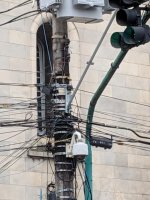My wife is a ER nurse who specialized in psych issues for many yrs, she once told me it takes 7 times (on avg) before something actually sinks in..........man I’ve played that tidbit to death! 😀
Ed: haven't you told that story before on this very thread?
Probably. But it does apply to the discussion as to why one should not add inductors to power mains.
I have seen Cat 5 blown apart/shredded, also plastic watering controller two wire line terminating/protection box blown off a wall and leaving imprint of the box lid embossed text on the opposite plasterboard wall !.Then there was the time we were replacing the sound system at a small American football field, the guys did a final hookup in a Monday and none of the far side loudspeakers worked properly. They had tested fine on Friday.
Turns out the folks who had installed the buried cable had grounded one wire. So when the weekend storm came in the loudspeakers worked quite nicely as lightning arresters. The inductors in the crossover were quite literally blown apart.
Just in case anyone was curious as to what happens to an inductor that passes a lightning surge.
I have also seen Fulgurites after the same storm 😱.
I have read if you are out fishing and one's hair is standing on end, immediately lift anchor and GTFOOT.I assume the bolt only hit one of the loudspeakers and it was the induced voltage that did in the rest.
Max don't use an umbrella when climbing the nearby tallest tree during a lightning event!
Trees already act as umbrellas, why would anybody climb a tree in a storm ?

Dan.
Last edited:
My experiment is to keep spikes/noise on the street Neutral out of the house PE network, the house PE network is connected directly to the well earthed grounding electrode.Probably. But it does apply to the discussion as to why one should not add inductors to power mains.
Where I live is low risk for lightning strikes, and in any case there is about sweet FA that can be done to prevent damage due to a direct hit.
Dan.
She only told you once lol ?.My wife is a ER nurse who specialized in psych issues for many yrs, she once told me it takes 7 times (on avg) before something actually sinks in..........man I’ve played that tidbit to death! 😀
Dan.
Here's something for someone else to test: if caught outdoors and exposed in a lightning storm, no ditches to get into, squat with feet close together and arms wrapped around knees, hands not touching the ground. Voltage gradients across the ground's surface can be hundreds of volts per meter before the strike.
If you're really flexible you might want to bend your head further down and kiss your sweet butt goodby.
All good fortune,
Chris
If you're really flexible you might want to bend your head further down and kiss your sweet butt goodby.
All good fortune,
Chris
If you're really flexible you might want to bend your head further down and kiss your sweet butt goodby.
All good fortune,
Chris
Quite honestly, I wish I were that flexible.
There appears to be something in the way....about 20 lbs of something..sigh.
Jn
There appears to be something in the way....about 20 lbs of something..
This could be considered to be bragging in one context, or an honest description of the life trajectory of all of us (male) primates in another. Personally, sadly, the latter.
All good fortune,
Chris
Yah, that thought came to mind long after I posted. Sadly, it is indeed trajectory..the constant battle between metabolism, pizza, and beer.
I am losing that battle.
However I am winning the tool battle. Just picked up a set of pin gauges from .011 to .250 inches in .001 inch increments (.0002" under), and a set of micrometers 0-1", 1-2", and 2-3".
No matter how good your machinery is, you can never make something of extreme precision if you cannot measure it.
On that note... Q..
By comparing amplifier output (at the terminals and also at the load) to input differentially, how deep a null has anybody achieved?
Also, what level of null is required at 1kHz to discern a time shift of 1 uSec assuming the level is dead on accurate? IOW, if the load, amp, and cable conspire to shift some frequencies of the signal by 1 uSec, can it be measured?
Ps. I know we cannot discern 1uSec, but we must be able to measure beyond our capabilities if we wish to be accurate.
Jn
I am losing that battle.
However I am winning the tool battle. Just picked up a set of pin gauges from .011 to .250 inches in .001 inch increments (.0002" under), and a set of micrometers 0-1", 1-2", and 2-3".
No matter how good your machinery is, you can never make something of extreme precision if you cannot measure it.
On that note... Q..
By comparing amplifier output (at the terminals and also at the load) to input differentially, how deep a null has anybody achieved?
Also, what level of null is required at 1kHz to discern a time shift of 1 uSec assuming the level is dead on accurate? IOW, if the load, amp, and cable conspire to shift some frequencies of the signal by 1 uSec, can it be measured?
Ps. I know we cannot discern 1uSec, but we must be able to measure beyond our capabilities if we wish to be accurate.
Jn
Last edited:
Apply a sinewave input at frequency f. Use one of those zippy fast Linear Technology voltage comparator ICs (7ns prop delay) to detect zero crossings of the input. Attach oscilloscope probe for Channel A to voltage comparator IC output. It's a square wave.
Connect a second voltage comparator IC to detect zero crossings of the output. Attach oscilloscope probe for Channel B to second voltage comparator output. It's another square wave.
Measure the time delay between zero crossing at input, and zero crossing at output. Plot time delay versus frequency f. Done.
Connect a second voltage comparator IC to detect zero crossings of the output. Attach oscilloscope probe for Channel B to second voltage comparator output. It's another square wave.
Measure the time delay between zero crossing at input, and zero crossing at output. Plot time delay versus frequency f. Done.
Apply a sinewave input at frequency f. Use one of those zippy fast Linear Technology voltage comparator ICs (7ns prop delay) to detect zero crossings of the input. Attach oscilloscope probe for Channel A to voltage comparator IC output. It's a square wave.
Connect a second voltage comparator IC to detect zero crossings of the output. Attach oscilloscope probe for Channel B to second voltage comparator output. It's another square wave.
Measure the time delay between zero crossing at input, and zero crossing at output. Plot time delay versus frequency f. Done.
many dual channel oscilloscopes will do all that for you and measure/display delay time.
-RNM
If desired, you could also connect a phase locked loop after the voltage comparator and before the scope probe, at both input and output. The flywheel-like behavior of the PLL's VCO will attenuate cycle-to-cycle jitter, giving a more stable chan1_to_chan2 delay measurement.
try this one.
DeltaWave Audio Null Comparator | DeltaWave documentation
some people trying to use it here, page 2
Do interconnect cables make a difference? A null test result | Page 2 | Audio Science Review (ASR) Forum
have not tried it or have any opinion
Cheers
Alan
DeltaWave Audio Null Comparator | DeltaWave documentation
some people trying to use it here, page 2
Do interconnect cables make a difference? A null test result | Page 2 | Audio Science Review (ASR) Forum
have not tried it or have any opinion
Cheers
Alan
Good for hearing room sound vs speaker sound, IOW useful for setting speaker placement.Any thoughts on this test? Online MATT Test| Musical Articulation Test Tones
Dan.
Last edited:
Thanks Alan, I didn't know about the graphing display function.try this one.
DeltaWave Audio Null Comparator | DeltaWave documentation
some people trying to use it here, page 2
Do interconnect cables make a difference? A null test result | Page 2 | Audio Science Review (ASR) Forum
have not tried it or have any opinion
Cheers
Alan
Perhaps I can use it to discriminate the Goop loopback recordings changes that Mountain Bob hears.
Dan.
Last edited:
Any thoughts on this test? Online MATT Test| Musical Articulation Test Tones
Seems like an interesting audible test of room smoothness/evenness or how flat/non-flat the listening position/room. The effect of such nonflatness has a particular sound effect with slow swept tone. Not too surprising but fun to hear.
THx-RNMarsh
- Status
- Not open for further replies.
- Home
- Member Areas
- The Lounge
- John Curl's Blowtorch preamplifier part III

